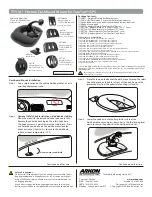
11
ED TRIPLET ESSENTIAL SERIES
are packaged in plastic bags and the telescope’s tube is wrapped in tissue. To begin
assembly, slowly remove the optical tube. All models will come with their cradle rings
attached, which makes for easy removal. Rarely, the cradle could have come open during
packing or shipping, so it is important to check the latches and then do a quick, small lift
by the cradle handle to make sure the ring is secure before pulling the instrument all the
way out. Although our telescopes are designed with portability in mind, it is important to
use proper lifting techniques to prevent back injury and/or strained muscles. Whenever
possible, use two people to move or lift the equipment and make use of wheeled devices
like carts or dollies for additional aid.
To begin assembly, slowly remove the optical tube from its foam casing. The 102mm,
127mm and 152mm models will all come with their cradle rings attached, which makes
for easy removal. Rarely, the cradle could have come open during packing or shipping,
so it is important to check the latches and then do a quick, small lift by the cradle handle
to make sure the ring is secure before pulling the instrument all the way out. Although
our telescopes are designed with portability in mind, it is important to use proper lifting
techniques to prevent back injury and/or strained muscles. Whenever possible, use
two people to move or lift the equipment and make use of wheeled devices like carts or
dollies for additional aid. Due to its necessary size and weight, the 152mm model’s case
comes with wheels for easier transport.
DEW SHIELD
The dew shield is an important part of your telescope because it slows moisture build-
up on the objective lens and can reduce image interference caused by ambient light. We
advise using the dew shield when possible to maximize these crucial benefits. For the
80mm, 102mm and 127mm models, the dew shield is an easy-to-operate retractable
style that slides smoothly up and down the optical tube assembly with no installation
required.
DIAGONAL
Astronomical observation usually requires the telescope to tilt up significantly, which
can make straight-thru viewing awkward and uncomfortable. A diagonal solves this
comfort problem by using a mirror to direct the light at a 90° angle toward the eyepiece,
which is positioned perpendicular to the OTA making the image more accessible.
Equipped to fit both 1.25” and 2” eyepieces, your telescope’s diagonal houses a precision-
polished, two-inch mirror that is 99% reflective to maximize light transmission. To
install the diagonal, begin by removing the dust covers from the focuser’s drawtube and
the diagonal itself. Loosen the screws on the drawtube’s tension collar, and slide the
barrel of the diagonal into the drawtube. Tighten the three tension screws to secure
it firmly. Should one of these tension screws accidentally become loose, the barrel of
the diagonal is tapered to prevent it from falling out of the focuser. The 1.25” eyepiece
adapter or 2” eyepieces can be secured in the diagonal by tightening the tension screws
on the compression ring lock. The 1.25” adapter also has a compression ring to secure
eyepieces that are inserted into it. Please note: Your telescope may come with extension
tubes for situations in which you need more back focus. Please see the “Focusers” insert
for more information on how to install these accessories between the focuser and the
diagonal.
Содержание TWILIGHT Series
Страница 1: ......
Страница 33: ...33 NOTES ...
Страница 34: ... 2016 Explore Scientific LLC All model names and logos are registered trademarks www explorescientificusa com ...












































